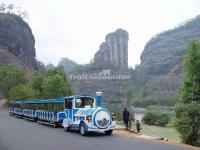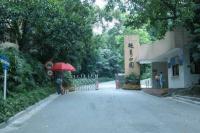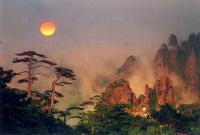Qing Dynasty
The Qing Dynasty was the second time when the whole of China was ruled by foreigners, the Manchu. The first time was during the Yuan Dynasty when China was controlled by the Mongols. The Qing Dynasty lasted from 1644-1911 A.D. The reigns of the first three emperors of this dynasty were a time of peace and prosperity for China. These three rulers provided strong leadership for 133 years; they were the Kangxi Emperor who reigned from 1662-1722 A.D., the Yongzheng Emperor who reigned from 1722-1736 A.D. In terms of government, the Qing Dynasty adopted the form of government used by the Ming, with only minor adjustments. For example the positions were all dual positions, one Manchu and one Chinese were in the same position, with the Manchu having more power. The form of military organization that the Qing used was one of the best in the world. They organized their troops under banners, each of which was a separate unit. The number of banners grew from 8 in the beginning to 24. These fighting men were personally attached to the emperor, in fact he owned them. They were incredibly loyal to the emperor. The bannermen also functioned as a talent pool from which civil bureaucrats could be chosen.
The Qing were very successful as foreign rulers in China. They maintained their domination of the Chinese by preserving their own identity. They spent their summers in their homeland of Manchuria, which was closed to the Chinese. They banned intermarriage among the Chinese, continued to speak their own language and did not make their documents available to the Chinese. They retained military strength over the Chinese by separating the duties of the Chinese troops and of the Manchu troops. The Chinese were not trained as a striking force. They also had a unique way of keeping the Mongols away. They first immobilized and divided the Mongols under a similar fashion as the Ming had done. However, they then supported the Yellow Lamaist sect of Tibetan Buddhism, which was a popular religion of the Mongols, and focused their attention on Lhasa, as a center of worship.
The Qing instituted changes in the dress of the Chinese. They required the Chinese men to shave their heads and wear queues. They also required them to wear Manchu clothes rather than the clothing style of the Ming Dynasty. The Qing did not require the Chinese women to change their dress, yet they did forbid them to bind their feet. This proved impossible to enforce and in 1668 A.D. the ruling was withdrawn. A custom the Qing did not attempt to change, was the preference for agriculture over trade. The Qing favored an isolationist policy, which proved fatal. The lack of trade hurt China economically.
The period of peace that followed the ascension of the Qing Dynasty allowed for growth in all areas. Public works were repaired and maintained. Taxes were very light as compared to previous dynasties, and in famine struck areas, taxes were reduced even further. Commerce and international trade grew. This peace allowed for a revival of arts and learning. The areas of the novel, short story and drama contain the most famous literary works. However, poetry, which was a more accepted form of writing, also flourished. The poems show no real innovation, they followed examples set forth by previous dynasties. Encyclopedic works were commissioned by the emperors. Porcelain production continued to be important and innovations were made in the use of new colors. Colors that developed were shades of green, and compositions of black and yellow. A dark blue and brilliant red were also used. Painting was also important, and for the first time European influences are seen. European missionaries were allowed into China and influenced Chinese ideas about science. However, Christianity was later outlawed when European ships with Christian sailors began looting the Chinese coast. Another reason for the outlawing of Christianity was disputes among the missionaries and a papal ecclesiastical policy that was contrary to Chinese policy.
During the reign of Qianglong, the borders of China were expanded to their greatest extent ever. His reign was the time of the greatest prosperity during the Qing Dynasty. However, there are also signs of internal problems. Popular uprisings occurred during this time, but they were all put down. The first uprising was in 1774 A.D. in Shandong, then in 1775 A.D. another uprising occurred, this time it was led by the secret society known as the Society of the White Lotus. In 1813 A.D., during the reign of Qianglong's successor, another uprising occurred which was led by the secret society known as the Society of Heaven's Law. The government, while they succeeded in suppressing the uprisings, did not succeed in alleviating the impoverishment that had led to these uprisings.
The impact of the west was also felt for the first time in China. Great Britain especially was interested in trading with China for silk and tea. However, the British did not have anything that was easy to import to China until they began importing opium. This was devastating to China. Many became addicted to opium, and land that had previously been used for food began to be used to produce opium. Also, a large amount of Chinese money left the country in payment for the opium. Finally, in 1839 A.D. the opium trade was abolished. This set off a war with Great Britain that came to be known as the Opium Wars, and in 1842 A.D., China was forced to sign a treaty in which Great Britain received Hong Kong, and ports were opened to European trade. The terms of this treaty were not fully carried out by either side, and in 1857 A.D., fighting again broke out. The British again won and the Chinese were forced to grant more privileges to the British, that virtually turned China into a British colony.
Internal rebellions further weakened China. The T'ai P'ing rebellion is one of the most famous. Its leader also instituted religious changes among his followers. He mixed elements of Christianity and traditional Chinese religion, along with ideas of his own. He believed in communal property, and the equality of men and women among other things. Other uprisings which greatly affected China were known as the Mohammedan risings, which were more separate events than uprisings connected to each other. The problems caused by internal rebellion were further intensified by Japan's Westernization and goal of conquering the surrounding countries to provide both a buffer against attacks against Japan itself and to provide trading networks. Russia too began to come into contact with China and treaties were signed which defined the China/Russia border and allowed for types of trade.
While these struggles were occurring, the emperors became younger and younger, so that they had no control and power was in the hands of empresses and other advisors. The empress who held the most power was Cixi. She was uneducated and opposed to any type of reform or modernization that might have helped China economically and politically.Reformers who felt that China had to change were executed, despite the validity of their arguments that people whom they had previously regarded as inferior and barbarians were easily defeating China. Cixi had the former emperor executed, and the next day, she too died, albeit of natural causes. However, before her death she placed a two year old on the throne. This further weakened the government and strengthened the revolutionaries. His reign lasted from 1909-1911 A.D., at which point the the revolutionaries won and the Republic of China arose.
List of Emperors of the Qing Dynasty
Personal name | Posthumous name | Temple name | Reign years | Era name and Range of years | |||
Nǔ'ěrhāchì | 努爾哈赤 | Gāodì | 高帝 | Tàizǔ | 太祖 | 1616–1626 | Tiānmìng (天命) 1616–1626 |
Huángtàijí | 皇太極 | Wéndì | 文帝 | Tàizōng | 太宗 | 1626–1643 | Tiāncōng (天聰) 1627–1636 |
Chóngdé (崇德) 1636–1643 | |||||||
Duōěrgǔn | 多尔衮 | Yìdì | 義帝 | Chéng zōng | 成宗 | 1643–1650 | |
Fúlín | 福臨 | Zhāngdì | 章帝 | Shìzǔ | 世祖 | 1643–1661 | Shùnzhì (順治) 1643–1661 |
Xuányè | 玄燁 | Réndì | 仁帝 | Shèngzǔ | 聖祖 | 1661–1722 | Kāngxī (康熙) 1661–1722 |
Yìnzhēn | 胤禛 | Xiàndì | 憲帝 | Shìzōng | 世宗 | 1722–1735 | Yōngzhèng (雍正) 1722–1735 |
Hónglì | 弘曆 | Chúndì | 純帝 | Gāozōng | 高宗 | 1735–1796 | Qiánlóng(乾隆) 1735–1796 |
Yóngyǎn | 顒琰 | Ruìdì | 睿帝 | Rénzōng | 仁宗 | 1796–1820 | Jiāqìng (嘉慶) 1796–1820 |
Mínníng | 旻寧 | Chéngdì | 成帝 | Xuānzōng | 宣宗 | 1820–1850 | Dàoguāng (道光) 1820–1850 |
Yìzhǔ | 奕詝 | Xiǎndì | 顯帝 | Wénzōng | 文宗 | 1850–1861 | Xiánfēng (咸豐) 1850–1861 |
Zǎichún | 載淳 | Yìdì | 毅帝 | Mùzōng | 穆宗 | 1861–1875 | Tóngzhì (同治) 1861–1875 |
Zǎitián | 載湉 | Jǐngdì | 景帝 | Dézōng | 德宗 | 1875–1908 | Guāngxù (光緒) 1875–1908 |
Pǔyí | 溥儀 | Xùndì | 遜帝 | None given | 1908–1911 | Xuāntǒng (宣統) 1908–1911 | |
Recommended China Tour Packages
-
3-day Mount Wuyi Highlights Tour
-
2-day Guangzhou Guided Tour
-
4-day Breathtaking Yellow Mountain Tour
















